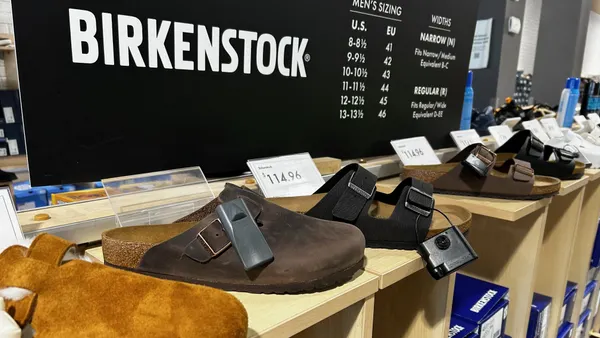It’s a rare event these days for a brick-and-mortar retailer to share a headline with Amazon and see its stock go up.
Sears Holdings — whose stock Wall Street in recent years has treated with all the deference of a sick, smelly dog — had such a moment last week when its stock jumped by around 15% after the troubled retailer announced it would begin selling its Kenmore appliance brand through Amazon’s e-commerce platform. The partnership, which includes connecting Kenmore’s smart appliances to Amazon’s Alexa voice assistant platform, created not only an expanded market for Sears’ brand, but also a path for Amazon to expand its online sales of heavy appliances.
In response to the announcement, shares of Home Depot, Lowes and other appliance retailers fell. Now that is a more familiar story: Amazon decides to do a thing, and markets and retailers tremble.
But, despite what the stock market does, the retail realities around appliance sales and Sears’ business remain in place, for now. Kenmore has lost market share and share of mind with customers over the years. The heavyweight retailers of appliances still have leverage over producers and can press them to avoid Amazon. And touching, feeling, talking and servicing are still integral to appliance sales, although e-commerce sales in the category are expanding rapidly.
As for Sears, it would need to sell a lot of Kenmore refrigerators and air conditioners through Amazon for the partnership to have a meaningful impact on its long-declining financial trajectory. That said, the deal holds at least the potential to drive new customers into stores and provide new data. After years of declining sales and hundreds of store closures, Sears has little to lose.
Not a one-sided deal
The companies released few details about the deal itself when they announced it July 20. Presumably, there is a financial arrangement between the two companies (meaning Amazon likely gets a cut of sales made through its website), though they would not say so and did not disclose details of the partnership. That makes it hard to know just how much promise the deal holds for Sears. (Amazon, meanwhile, has never showed much interest in how much money it makes from any given venture, at least initially.)
Both Sears and Amazon both declined interviews for this story. Matt Furlong, General Manager of Home Improvement and Major Appliances at Amazon, said in a statement emailed to Retail Dive, "We’re constantly working to expand our selection and are excited to be offering customers Kenmore appliances on Amazon.com.”
Sears will reverse the typical Amazon model by sourcing the delivery logistics through its own Innovel Solutions unit, as well as taking on the servicing of appliances. (Sears would not say how much delivery for appliances sold through the partnership would cost customers.) The department store retailer said on its blog it would begin by making smart air conditioners available for purchase immediately.
While it might seem that any negotiation between the two companies would be asymmetric — with Amazon the ascendant retailer boasting explosive revenue and category growth and Sears the retrenching former force of American retail — Amazon has plenty to gain as well. The internet retailer has been looking to break into appliance sales, which have seen relatively low e-commerce penetration.
That is quickly changing, though. E-commerce sales of appliances have grown 35% over the past 12 months, Joe Derochowski, home industry analyst at NPD, told Retail Dive. He attributes the growth to a widening product assortment online, demand for appliances across key demographics, the ability to source customer reviews, and new technology such as augmented and virtual reality that allow customers to see products in their home, as well as online pricing.
“I would not look at this deal as being one-sided to the advantage of Amazon.”

Greg Portell
Lead partner of consulting firm A.T. Kearney’s retail practice
The growth and potential for online sales of appliances is no doubt alluring to Amazon, which has had a lust for category expansion for much of its life.
"Let’s say Amazon makes this strategic decision to get into this space — one, because they want the category online, and two, because they want the connectivity [through Alexa] — what brand would they go to that doesn’t view them as an incredible threat? The list gets pretty short pretty quickly," Greg Portell, lead partner of consulting firm A.T. Kearney’s retail practice, said in an interview with Retail Dive. "I would not look at this deal as being one-sided to the advantage of Amazon."
Even though Sears is a rival retailer, Amazon also has incentive to market Kenmore products by moving the brand to prime search real estate and giving attention to the visual layout of Kenmore pages on Amazon.com. “If we think about traditional brands in a retail environment, whether it’s online or brick-and-mortar, the brands are investing trade dollars, and the retailers have a vested interest in selling and moving that brand," Portell said.
"So you can absolutely see how Amazon will want to sell those products," he added. "Now, when you add in the twist that it’s going to be powered by Alexa capabilities, then Amazon definitely has an interest in selling that product. And that’s all good. This is the way brands and retailers are supposed to work together, it’s just a little bit different because Sears is a retailer in the traditional view."
New life for a ‘dying’ brand?
But will the partnership displace other brands and other retailers of appliances?
Jeffries analyst Daniel Binder described, in a note emailed to Retail Dive, the market reaction to the Sears-Amazon team up as "overdone," noting that "Kenmore brand equity has declined." More bluntly, he described Kenmore as "a dying brand."
“Just because Kenmore is available on Amazon doesn’t mean customers are going to want this dying brand anymore than they do now."

Daniel Binder
Jeffries analyst
Selling Kenmore appliances through the largest e-commerce platform in the country is certain to expose Sears to a larger and broader audience for the brand. Sears noted at the time of the announcement that the Amazon partnership was the first of its kind and represented the widest distribution of Kenmore outside of Sears’s own stores and websites.
But Binder argues that "just because Kenmore is available on Amazon doesn’t mean customers are going to want this dying brand anymore than they do now, especially as news of Sears’ future grows more negative and the industry moves toward more smart appliances, hence giving customers more options beyond Alexa."
Top appliance retailers, among them Lowes and Home Depot, have longstanding relationships with producers and have so far stood between them and the e-commerce giant. Online penetration of appliance retail remains below 15%, according to estimates by Binder, who writes that “manufacturers value their relationship with the … largest national retailers selling their products and the floor displays and post-purchase service they provide such as delivery and installation."
In other words, producers don’t want to cross the big box retailers by giving Amazon a path into their business. That could leave Amazon with few appliance offerings beyond Kenmore for the foreseeable future.
A ‘positive’ step, but no game changer
If the deal is unlikely to kill off the appliance heavies in the retail world, it’s not likely to be Sears’ salvation either, given the company’s deep and well-documented financial concerns.
As David Silverman, senior director for retail coverage at Fitch Ratings, pointed out in an interview, Sears still needs $2 billion of liquidity annually to survive as a going concern. "With regard to the overall credit story, we don’t think this is a game changer or a material change in any way," Silverman said. "It’s obviously a positive step for them to find this type of partnership, but in and of itself it’s not a material game changer in the overall Sears story."
And while Sears could boost sales of the Kenmore brand through the Amazon deal, the retailer runs the risk of cannibalizing sales from its stores. "Is every sale they do out of Amazon potentially taking market share from someone else, or is it a sale they would have done out of their own store anyway, and potentially less lucrative because Amazon takes a piece of that?" Silverman said.
"Is every sale they do out of Amazon potentially taking market share from someone else, or is it a sale they would have done out of their own store anyway, and potentially less lucrative because Amazon takes a piece of that?"

David Silverman
Fitch Ratings analyst
Conversely, the deal could drive traffic to Sears’ store, potentially from customers who are loyal Amazon shoppers and want to see a Kenmore appliance in the flesh (or metal, as it were) before buying. New traffic, in other words, which Sears desperately needs.
"For Sears… this needs to be a building block for positive momentum," Portell said. "Yes I’m giving up margin, I’m giving up units. Even if it’s mostly accretive, it’s still going to cannibalize — it just has to in any scenario. But the promise is you’re driving traffic into your store. … "If I’m Sears I’m looking for a way to turn that showrooming effect to sell other products and connect with customers I didn’t connect with before."
Moreover, Portell expects Sears to get data on these customers through the deal, such as the names and contacts of new customers shopping for Kenmore appliances, which it could then combine with its own data, drawn mainly from its Shop Your Way platform, on other products those customers might be interested in. "The Amazon relationship allows Sears to get a profile of a consumer that would not have walked into their store cold," he said. "It opens up the world for Sears."
Kenmore’s future
For Sears to execute on the brightest potential of the Amazon deal, it needs talent, resources and time — all of which are constrained by the company’s financial struggles.
And it wasn’t that long ago that Sears was openly shopping the Kenmore brand around, looking for a cash infusion to help shore up its balance sheet. (It did get one with its Craftsman brand earlier this year, selling it for $900 million in a move that shocked observers and dismayed some.) Could the partnership with Amazon raise the profile of Kenmore enough to raise its value in the eyes of a prospective buyer? Maybe, but maybe not.
"Simply having strategically that partnership could be seen as a positive," Fitch’s Silverman said. "I would also say that’s a positive for many potential buyers of the brand, but frankly it could also be considered neutral to potentially negative. To the extent that another retail company might be looking at purchasing the brand, the fact that they have a relationship with a competitor may not be as attractive."
For Amazon’s part, it’s history of partnering with retailers and brands is checkered at best. In his book "The Everything Store," Businessweek writer Brad Stone documented the fraught relationship between Amazon and Toys "R" Us and other retailers who have teamed up with the internet giant to sell through Amazon’s site. Amazon also has a habit of observing and collecting data on brands and retailers who sell through its marketplace prior to making its own play for that category.
That’s likely why other appliance retailers and brand owners see Amazon as a threat, not a potential partner. But Sears has less to lose than Lowes or Home Depot, who so far have been insulated from e-commerce encroachment on their business. And it’s possible Sears, with the deal, is prospecting the brand as much as it’s trying to sell more Kenmore appliances.
If the deal helps change the trajectory of the Kenmore brand — which has seen its market share slip from 40% some 20 years ago to around 12% today as its customer base ages and younger generations overlook the brand — it could give "optionality," or a brighter set options for selling or holding onto it, Portell said.
Could Amazon be a potential buyer for Kenmore? That depends on Amazon’s (well-guarded) private label expansion plans. "It’s hard to build private label strategy based on lilly pads, where you’re jumping from here to there," Portell said. "It’s much easier to build connected category growth. But Amazon being Amazon, they tend to do a little bit of the unexpected."






















